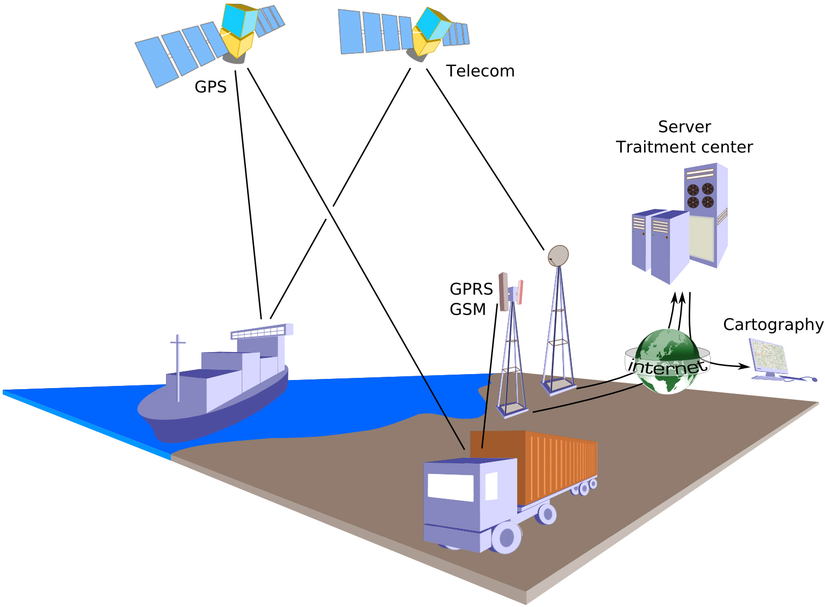One of the emerging applications of fleet management is in the area of GPS-based automatic vehicle localization (AVL) systems. This technology merges on-board diagnostics of a vehicle with satellite-based GPS data and provides the advantage of expected locating of a private or public transport vehicle. AVL also plays a role in locating the crew while proving handy during any on-road emergency situations.

Image Courtesy: Wikipedia
Vehicle tracking is the most common function of AVL systems usually performed by a GPS-based and/or a cellular-based system. Using GPS, vehicle location, speed and direction can be obtained through either both terrestrial or satellite navigation technologies. Although satellite communication can be costly, it can prove very critical during emergency situations in pinpointing the exact location even though the accuracy cannot be always counted upon. Terrestrial GPS, on the other hand, relies on ground data (e.g. Google Street View) which enables far more precise tracking (<10 meters) depending on the strength of the signal.
By integrating AVL technologies, users can see actual and real-time locations of their fleet on a map. This way they can quickly respond to events in the field. One can track the route followed by the vehicle and identify if any changes are needed in the subsequent path. From a control center, it is possible to optimize the time between driving and resting time and so forth.
AVL technologies play a great role in synergizing various routes, thereby optimizing them based on algorithms running on centralized servers. Having cellular technologies in addition to GPS provides an added advantage of reading the OBD (On-board diagnostics) data and relaying it to central server for health status as well as raising alerts based on situational analysis.
AVL systems can further confirm that the service area is being run according to a pre-defined schedule while facilitating the operator’s task of monitoring services and dealing with problems, such as delays due to traffic congestion and breakdowns. They also predict the ability to calculate the time of dispatch, while being more reactive to the changing circumstances.
The following are the most common technologies that are used in automatic vehicle management (AVL)-based fleet management systems.
Detector loops:
These devices are based on the road surface itself in order to communicate with transponders tags on vehicles passing around them. The loops contain registered information from the transponders which are then passed on to a local centralized unit closer to the street or the control center.
Global Positioning System (GPS):
The system can read signals from multiple satellites that are required to calculate the surface position of the vehicle with the help of radio receiver. In some particular cases, when GPS is not working, vehicle location can be determined using a signal from a gyro-sensor.
DGPS:
DGPS is an acronym that stands for differential GPS whose main purpose is to correct the errors in navigation in order to provide improved location accuracy. The basic idea is to reduce GPS inaccuracy at a stationary receiver station using a site that was previously located. Here, the DGPS hardware already knows the position. And that makes it easy to calculate the error caused by GPS. The station will send a radio signal to all DGPS-based receivers in the localization, corrected signal information for that area. Thus, access to this corrected information makes DGPS receivers much more precise than ordinary GPS receivers.
Central system:
All the data transmitted and received from either multiple sensors or the various systems are further controlled by a centralized system. These may be beacon-based solutions on one of the standard wireless interfaces like ZigBee or BLE.
Monitoring Module on a real-time basis:
All the functionalities that have a real-time influence on the management of the fleet and the information fed to central system are included in the monitoring module. They consist of an easy-to-read or pictorial representation of the real time status of services for any transport operator, along with a system for automatic services, and driver communications. The conversation with drivers may be accomplished automatically with an encoded message or direct involvement of the operator.
Service planning module:
Service planning modules are required to enter the schedule data, the fleet service that is necessary to be planned in advance. Operational records can also be used for forthcoming planning of services and planning the regular maintenance of vehicles.
In summary, the various advantages of AVL systems in fleet management are:
- Increased operational performance and reduced cost of running services
- Efficiency in the use of fleet vehicles
- Regular and dependable service
- Reduced costs in fuel management
- Reduced vehicle maintenance cost due to optimized usage
- Minimal wait time and trip duration
- Precise and consistent real-time information












